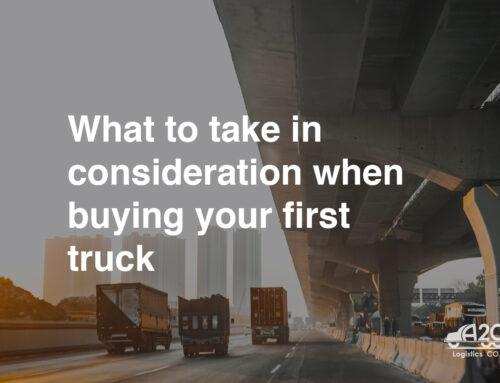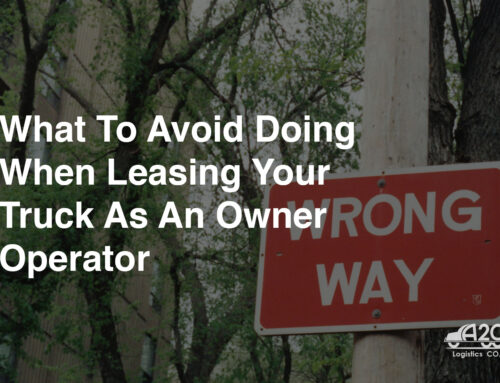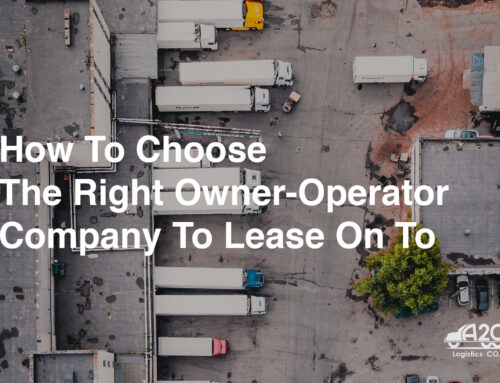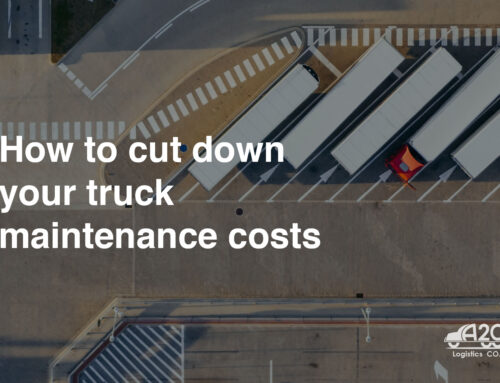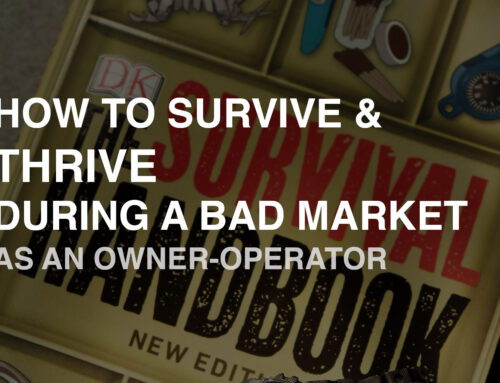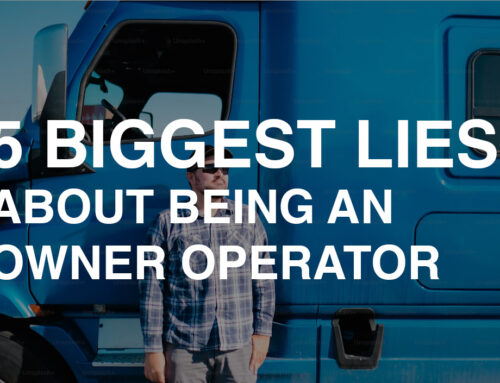
At some point in most truckers’ lives, they’ve thought about hitting the road as an independent services owner-operator. Becoming an independent owner-operator can be a great career. Essentially, as a truck owner-operator, you are not only creating your own business, but you are your own employee as well.
However, if you’re considering becoming an owner-operator, there are several details that need to be weighed in before you make a final decision. Like in every career choice, there are pros and cons. You need to look at all the angles before taking the leap.
So, to not keep you wondering what you might need to do in order to become an owner-operator, we are going to cover the basic requirements to help you out.
In this article we covered some key aspects to guide you:
- The need for a business plan;
- Obtaining your CDL;
- Expenses & Finances;
- Owner-operator’s equipment;
- Insurance;
- Federal & State regulations;
But first thing, is this right for you?
The idea of being your own boss might sound amazing, but the fantasy sometimes overshadows the work involved. As an owner-operator, you need to weigh how much time and commitment is required to run a business.
If you enjoy spending a lot of time with your family, you need to understand that the sacrifice of being away from home won’t disappear. In fact, as a business owner, this time away from your dear ones might increase dramatically.
As a company driver, your responsibility is limited to the scope of your job. However, this changes when you’re an owner-operator.
As such, the first step should be evaluating your situation. You need to consider if becoming an owner-operator will suit your lifestyle. Not only that but also consider whether you are physically fit to complete the work.
If you want to succeed in the business, don’t just jump ahead on this career path. Ask yourself first how much you know about the trucking industry and how many people you know.
Last but not least, if you have less than 3 years of experience, you should consider working as a truck driver some more time, in order to gain enough experience.
Obtaining your Commercial Driver’s License

At this stage, you should already have a CDL license, however, if you need more information about it you can read our short article on how to obtain your Commercial Driver’s License.
Develop a business plan
Being an owner-operator means starting up a business where you are the sole employee.
A business doesn’t just start by itself, so it’s fairly obvious that you need a business plan. It should clearly show what your revenue and expenses will be. A good tip is to keep in mind that your expenses need to include the money that you pay yourself for living expenses.
Research Trucking Industry
In order to develop a plan, my first suggestion is that you research the industry. Do your homework so to say.
Consult with owner-operators you already know and others who know about running a business (be that tax professional or even small business owners). They are the ones who can give you firsthand information about what you can expect as an owner-operator. Not only that, but they can offer invaluable advice from their own experience.
Having a good plan may help with everything from securing any financing you may be looking for to keeping you on track and getting everything completed in a timely manner.
Company Structure
Some common structures of trucking businesses include sole proprietorship, partnership, LLC (limited liability corporation), and corporation. Each structure has its own advantages and disadvantages based on liability and taxes.
If you feel like you are not prepared to do this by yourself, there are people to help. You may want to hire a business consultant to help you choose makes the most sense for your business. We highly suggest that you seek advice from other experts, such as attorneys and accountants, as they will help you choose the best business type for your operation.
Expenses and Finances
Having a business plan should make understanding your finances much easier. You need to make sure you have a plan to cover the costs until you start turning a profit.
There are some hidden costs associated with becoming an owner-operator. You should think about weight taxes, registration fees and you will also need to pay for licenses and endorsements.
You’ll also need to account for maintaining your trucking equipment, handling any loans or leases, tackling insurance, and then saving enough to actually pay for living expenses. The freedom of becoming your boss means that you will have to manage these financial responsibilities as well.
Profit
The faster you understand the following equation, the better your chances of being successful in this industry get:
Revenue per mile – Cost per mile = Gross revenue – Taxes = Net profit
To give you some insight into what each of these means:
Revenue per mile – how much money your company is generating for the services provided;
Cost per mile – the cost of a certain distance traveled by working vehicles;
Gross revenue – the income from sales;
Taxes – the sum of money the government demands for its support or for specific facilities;
Net profit – the money you have left after all the expenses (also known as net income);
Managing Costs
As an independent owner-operator, your goal is likely focused on growing and maximizing profits. As such, you’ll need a strategy to increase your revenue, while minimizing operation expenses.
To give you one example, one large expense might be the cost of fuel. However, you can minimize fuel expenditures. According to some studies, you can improve your fuel efficiency by as much as 27% by driving at 65 MPH instead of 75 MPH.
So staying within the 65 MPH speed limit instead of going faster should save you some money. Also, look for routes that will be fast and short, and consider looking for jobs that begin near your destination.
Another way to minimize your expenses is to check your vehicle’s health frequently. While this might sound like being more costly, it can actually help you avoid future severe maintenance issues.
We also recommend installing a dashcam. While this might not seem a priority, they help protect drivers and companies against crash-for-cash scams and other potential liabilities. This may help to get you exonerated and even lower your insurance premiums.
Owner-operator much-needed equipment
So you’ve come to the exhilarating, scary moment, when you invest your savings or take out a loan to purchase a truck.
You have to carefully consider every aspect of the type of operation you hope to run. For instance, you will need a truck and trailer for most loads, but you may also need specialized equipment for long or wide loads.
When deciding to purchase a truck and trailer or lease one from a trucking company, you have several option:
- Lease – bear in mind that if you choose to lease, you may also need to perform work for the company you are leasing from, as part of the lease agreement;
- Lease-to-own – some companies offer a lease-to-own option. This means that you lease on a payment plan until you pay it all off or until you pay a certain amount before owning it outright;
- Purchase;
Bank Loans
No matter the choice, how much money you have will play an essential part in obtaining your trucking equipment. Don’t rush into choosing your equipment – it’s best to take your time until you find the best deal you can.
We recommend looking for a bank that has a low-interest rate. Keep in mind that having a solid credit score helps with better interest rates.
Some of the factors that may affect your interest rates are your credit history, permanent address, and stable job background.
If you are worried about not getting a low-interest rate at a bank, there are other ways of funding available. Some of these alternatives are captive lending institutions (companies owned by truck equipment manufacturers) and commercial lending institutions. Lending institutions are finance companies that are not necessarily affiliated with truck manufacturers but cater to them.
Obtain insurance
Depending on the area you are in, different laws apply. Typically, owner-operators need general and primary liability coverage to operate their trucks legally. These types of insurance will cover damage to another vehicle or driver in the event of an accident and any damage to a loading facility or cargo during transportation.
Rates vary depending on your driving record, your state of residence, and where exactly you plan to operate. Owner-operators with their own authority report wildly varying rates – starting from $8.000 to more than $20.000 annually.
Regardless of your driving record, you will still be viewed as risky, being a new business. The good news is that most owner-operators reported primary liability rates falling in the first few years of operating.
BMC-91 form
Once you secure your insurance, you will need a BMC-91 form submitted to the Federal Motor Carrier Safety Administration (FMCSA). This filing guaranteed the FMCSA that you have enough liability insurance to cover the increased risk of transporting goods across state lines.
The insurance usually only applies to primary liability. Because of this, you may also need additional coverage that includes:
Non-Trucking Liability Insurance – this covers the driver if they are not currently performing duties directly for the motor carrier.
Physical Damage – covers the cost of damages dealt with your vehicle if it’s been involved in a collision.
Cargo Coverage – covers the goods you’re hauling in the event of damage or theft.
Lease Gap Coverage – covers the difference between the actual cash value of your vehicle and the unpaid balance on your loan or lease if your vehicle is totaled due to a loss covered by your comprehensive or collision insurance.
Comply with federal & state regulations
At this point, you are very close to having everything you need to get your business as an owner-operator operational.
Now, we are going to introduce you briefly to the permits and licenses you will need in order to operate legally. This will take a little extra research on your side as well, as they all depend on the types of loads you are planning on hauling, where your home jurisdiction is, and where you plan to travel to.
So, here is a rundown on the operation authorities:
DOT numbers and MC numbers
To become a driver-operator, the U.S. Department of Transportation (DOT) requires carriers to have a unique identifier that is used to collect and monitor safety information, inspections, crash investigations, and others.
To register for a USDOT, you need to visit the online portal Unified Registration System and submit a $300 payment. Once you have a DOT number, your next move is to secure an MC number if you want to freight regular commodities.
The usual owner-operator requirements that need a USDOT and MC number include:
- Working as for-hire carriers;
- Operate a CMV to transport passengers across state lines;
- Freight federally-regulated commodities across state lines.
IFTA: International Fuel Tax Registration Agreement
The International Fuel Agreement (IFTA) is an agreement between the lower 48 states of the United States and the Canadian provinces, to simplify the reporting of fuel use by motor carriers that operate in more than one jurisdiction. Carriers file a quarterly fuel tax report that determines their tax and distributes it to the states.
You will need to display your fuel credentials under the IFTA program if your vehicle has two axles and the weight grosses over 26.000 pounds or if it had more than two axles.
IRP: International Registration Plan
IRP is a US-based registration reciprocity agreement among states of the United States, the District of Columbia, and provinces of Canada, including Ontario. The plan distributes commercial vehicle registration fees based on the total distance traveled in each place.
As such, if you plan on leaving your home province, you will be required to obtain an International Registration Plan.
IRP plates are purchased annually, and fees are calculated based on prorated mileage and weight. Some provinces and states might charge additional taxes along with the plate fee.
BOC-3 Filing
BOC-3 is an Agent of Process – it stands for Blanket of Coverage. An Agent of Process is a legal firm that is authorized to receive and forward legal documents in case of a legal proceeding in a given state.
Carriers must designate such an agent to whom court papers may be served in a legal proceeding using FMCSA’s form BOC-3. You will need to designate a process agent in each state where you maintain an office or establish contracts.
UCR: Unified Carrier Registration
UCR is a state-level program that apportions its fairly low fee among the states annually to fund state motor carrier registration and safety-related activities.
All entities with an active DOT number must file an annual Unified Carrier Registration (UCR).
Fees are based on the size of the fleet and in the past two years it’s been the same – $59 for carriers with one or two trucks, rising from there for more power units. This must be renewed annually.
Heavy Vehicle Use Tax
If you operate a heavy vehicle, you’ll be subjected to the Heavy Vehicle Use Tax (HVUT). This is an annual fee that allows you to operate a commercial motor vehicle equal to or exceeding 55,000 pounds in weight. Unless you have proof of payment of the HVUT, you will not be able to operate on US public highways.
Fees are based on the weight of the vehicle and are prorated based on the first date of use. So, if you are driving a heavy vehicle, you’ll be needing to complete the IRS form 2290. If the commercial motor vehicle is driven less than 5,000 miles a year, then that vehicle is exempt from this tax. However, the IRS form still needs to be filled out.
Hazmat, tobacco, alcohol, and other regulated products
If you wish to haul Hazardous Materials, tobacco, alcohol, and other regulated products, there are several specific permits and licenses you may have to apply for.
For Hazardous Materials, you will need to register with the Pipeline & Hazardous Materials Safety Administration. For Tobacco and alcohol, it varies from state to state, as some require permits, reports, and/or registrations based on commodity or pick up and delivery.
Drug and Alcohol Programs
Whether it is complying with government regulations or customer contracts, it’s important to stay legal by managing your drug and alcohol testing program. In the United States, drivers can not be dispatched on new hires until the carrier receives a negative pre-employment drug test result.
The FMCSA New Entrant Safety Assurance Program
The FMCSA New Entrant Safety Assurance Program applies to all new carriers starting operations as Interstate Carrier in the United States. It monitors motor carriers’ compliance with safety regulations for their first 18 months of operations. In order to obtain your permanent operation authority, you must pass this audit. Auditors will examine all your files, logbooks and other documents and records to ensure that the carrier is complying with all the safety regulations.
Conclusion
Owning your own business requires talent, perseverance, and hard work.
It takes constant research and it requires you to be connected to your network of colleagues on a constant basis, to learn as much as you can from their experience and what they find challenging.
Hopefully, everything we’ve suggested so far was of some assistance and will make your job much easier.
Learn next how to find loads as an owner-operator.

